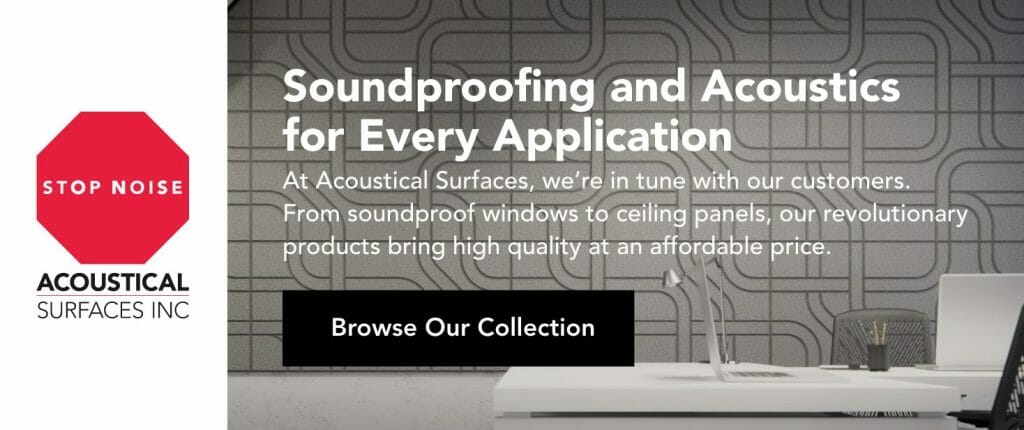Strategies to Eliminate Flutter Echoes
Sound control is a meticulous process that blends science and design to create an acoustically-pleasing environment. Even minor mistakes in the room design, structure, and materials can cause cascading sonic issues that distract or distort sound within the space.
For instance, flutter echoes are a common acoustic phenomenon that can wreak havoc on the quality of sound in a room, turning a finely-tuned auditory experience into a disconcerting echo chamber. These echoes, while seemingly innocuous, can be quite stubborn and pervasive, adding an unexpected layer of complexity to what might otherwise be a perfectly-designed acoustic environment.
But what are flutter echoes exactly? And what are strategies for mitigating or eliminating them?
This guide on flutter echo treatment has you covered.
What Are Flutter Echoes?
Flutter echo is a specific type of echo that sounds like a phantom “zinging” noise that travels with the main sound, creating an audible distortion that can be heard quite easily. In practical terms, it’s akin to playing an audio track and then playing the same track with a slight delay, causing the tell-tale fluttering sound.1
To better understand what this sounds like click on this video for a clear example.
An echo flutter occurs when sound energy is trapped and continuously bouncing between two parallel surfaces in a repeating loop, producing a series of rapid sound reflections in short time signatures. It’s most commonly found in spaces with hard reflective walls.
While this can create sound distortion that impacts the audio in practically any room, it’s especially troublesome in a sound recording studio where the microphone picks up those trailing reflections, which overlap with the direct sound, making it muddy and unclear.
What Causes a Flutter Echo?
Flutters often occur between walls, and it’s predominantly a middle and high-frequency issue since longer low-frequency waves are less likely to get trapped in these smaller dimensions.
A flutter echo can arise in practically any type of room; however, certain characteristics can increase the likelihood of a flutter echo occurring:
- Material properties – A hard, flat, reflective surface like concrete, glass, or wood are infinitely better at reflecting sound waves than absorbing them. This excessive reflection of sound trapped between parallel surfaces can contribute to flutter echoes.
- Parallel surfaces – Square and rectangular rooms—places with parallel surfaces—tend to amplify this sonic phenomenon. While designing a room with curves and angles may minimize the likelihood of a flutter echo, it can’t guarantee that it will eliminate it entirely.
- Lack of absorption – As mentioned, many of the standard surfaces of the walls, ceilings, and floors may lack natural sound absorption properties, which are necessary to absorb and dissipate sound energy.
- Furniture arrangement – In a similar vein, the positioning of furniture, especially items made of wood or metal, can either cause or worsen a flutter echo. These materials can act as parallel surfaces that trap sound, leading to a persistent reflection and amplification of the echo effect.
Strategies for Treating Flutter Echoes
If you operate in a space that has a flutter echo, there’s good news. There are actionable steps you can take to either minimize or eliminate the flutter echo altogether. Naturally, the exact steps you can take will depend on the room and its specific characteristics. Even so, some of the general practices include:
- Introduce basic absorption – For starters, adding softer materials to the walls, ceilings, and floors of any space can begin to eliminate any echo. Items like carpets, upholstered furniture, and heavy curtains can act as the first line of defense.
- Introduce advanced absorption – While the items above can begin to enhance the room acoustic characteristics, today, there are dozens of specialized acoustic products precisely designed to enhance the sound in a space like rigid fiberglass panels. For instance, strategically placing acoustic panels with a class A fire rating on the walls and ceilings can counteract echoes. And, bass trap in the corners can absorb low-frequency sounds that cause bass reflection flutters.
- Add diffusion – Diffusion represents the tail side of the sound-absorbing coin. By adding elements with varied shapes, depths, sizes, and angles, you can create complex, non parallel walls or surfaces that scatter sound wave, thus reducing the potential for flutter echoes.
- Altering Surfaces – Breaking parallel surfaces, either by designing a room with more angles or curves or by adding furniture to a space can help minimize or prevent flutter echoes.
Say Goodbye, Goodbye, Goodbye to Echoes with Acoustical Surfaces
A flutter echo is a repetitive sound reflection that occurs when the sound wave is trapped between parallel surfaces. It often creates a distinctly disorienting sound that can degrade the acoustic quality of any space.
Fortunately, there are strategies and specific products designed to restore clarity and resonance to the affected spaces.
At Acoustical Surfaces, one of the best anti-flutter echo products is the Noise S.T.O.P. Fabrisorb. These decorative fabric-wrapped acoustic ceiling baffles can be strategically hung in large spaces with high ceilings to prevent flutter echoes and provide noise reduction. And this is just one of many products we offer that can help any space sound more acoustically optimized.
Want to learn more? Reach out to our sound experts today.
Sources:
- Sound on Sound. Is flutter echo a problem in a well-treated room? https://www.soundonsound.com/sound-advice/q-flutter-echo-problem-well-treated-room




